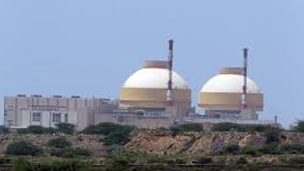The power crisis in Tamil Nadu, which had eased during June-September with around 2,000 MW of wind power generation, has again escalated, resulting in power cuts for industries and commercial establishments.
The power crisis in Tamil Nadu, which had eased during June-September with around 2,000 MW of wind power generation, has again escalated, resulting in power cuts for industries and commercial establishments.
As a result, all eyes are on an early commissioning of the first unit at the Kudankulam Nuclear Power Project (KNPP).
The KNPP, when operated at its rated capacity of 1,000 MW, would feed around 400 MW to the state grid and 600 MW to neighbouring states.
However, officials at the Tamil Nadu Generation and Distribution Corp Ltd do not rely much on possible power generation from the mega atomic power plant.
“We do not take into account the Kundankulam plant in our demand-supply calculations,” a senior official told IANS.
The Tamil Nadu government Monday announced 20 percent power cut for high tension industries and commercial establishments. During peak hours (6 p.m. to 10 p.m.), the cut would be 90 percent.
“We expect around 2,000 MW of fresh thermal capacity early next year to take care of the increased demand. Further, we hope to fix the problems of transmission corridor by early 2014 to bring in around 1,000 MW from other states,” the official said preferring anonymity.
The Nuclear Power Corp of India Ltd (NPCIL) is setting up two 1,000 MW Russian reactors at Kudankulam in Tirunelveli district, around 650 km from here.
The KNPP is India’s first pressurised water reactor belonging to the light water reactor category.
The first unit attained criticality, which is the beginning of the fission process, for the first time July 13.
The NPCIL had earlier said it would connect the first unit to the grid end-August, generating 400 MW power.
The one comforting news about the atomic power in the state is the restarting of the second unit at the Madras Atomic Power Station (MAPS) Sep 29.
The MAPS, run by NPCIL, has two reactors of 220 MW each at Kalpakkam, around 70 km from here.
Both units have been functioning below their rated capacity owing to paucity of fuel.
On April 15, when the second reactor was operating at 110 MW, the unit tripped due to a fault in the generator transformer’s high-voltage bushing. The reactor was shut down.
A new transformer was bought from Kochi in Kerala to restart operation.
“The unit is running smoothly generating 170 MW,” MAPS station director T.J. Kotteeswaran told IANS.
Meanwhile, the country’s first 500 MW indigenously designed prototype fast breeder reactor (PFBR) is being built by Bharatiya Nabhikiya Vidyut Nigam Ltd (BHAVINI) in Tamil Nadu.
A fast-breeder reactor is one which breeds more material for a nuclear fission reaction than it consumes.
It is the key to India’s three-stage nuclear power programme.
“We expect the PFBR to attain criticality (start of fission process for the first time) any time between March and May 2014. Our target is March 2014. We are working with the AERB (Atomic Energy Regulatory Board) for that purpose,” a senior official associated with the project told IANS.
According to atomic energy officials, a metallic fuel reactor (likely capacity of 500 MW) will also be set up at the Kalpakkam complex by the Indira Gandhi Centre for Atomic Research (IGCAR).
It will be the third reactor for IGCAR, which already has a fast breeder test reactor (FBTR), a mini Kamini (Kalpakkam mini reactor) and one for the whole of Kalpakkam nuclear complex.
A small light water reactor belonging to the Bhabha Atomic Energy Centre (BARC) is also operational at the Kalpakkam nuclear complex.
India’s first fast reactor fuel cycle facility (FRFCF), involving an outlay of around Rs.9,600 crore that got the Centre’s nod recently, will be set up in Kalpakkam.
IANS





